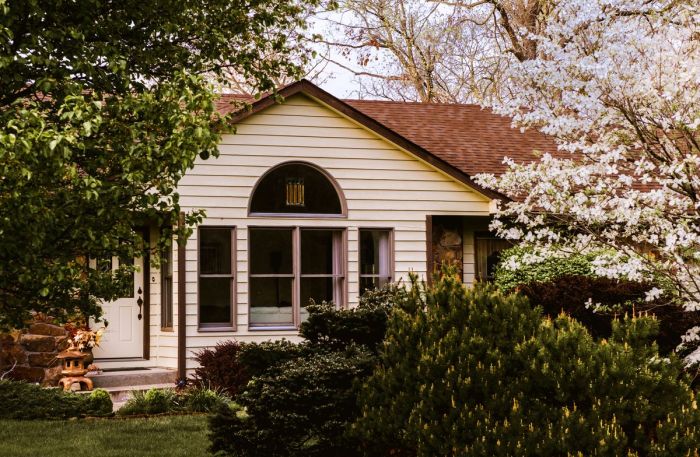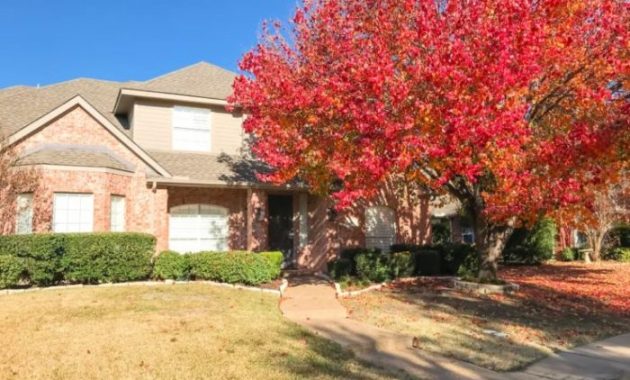Choosing Trees Based on Climate and Soil

Trees to plant next to house – A silent symphony of rustling leaves, a whispered promise of shade—the choice of trees for our homes, a melancholic dance with nature’s whims. The earth sighs beneath our feet, a silent plea for understanding, as we seek to intertwine our lives with the ancient wisdom of the woods. The right tree, a harmonious note in the larger composition of our lives, requires careful consideration.
Climate’s Influence on Tree Selection
Climate, a capricious conductor, dictates the rhythm of a tree’s life. Temperature extremes, the relentless beat of the sun, and the chilling touch of frost—all sculpt the destiny of each sapling. Trees, like fragile melodies, react differently to these forces. A species thriving in the scorching embrace of the desert might wither under the relentless rains of a temperate zone.
Similarly, a tree accustomed to the biting chill of a northern winter may succumb to the unpredictable warmth of a milder climate. Understanding these climatic nuances is crucial for selecting trees that will flourish, not merely survive. For instance, a citrus tree, a sun-drenched lover, would struggle in a region with frequent frost, while a hardy maple would likely thrive.
The delicate balance of heat and cold, moisture and dryness, must be meticulously considered.
Soil Type and Tree Compatibility
The earth, our silent partner in this endeavor, offers a diverse tapestry of soils, each with its unique character. Sandy soils, loose and free-draining, are suitable for trees with deep root systems, while clay soils, dense and water-retentive, favor trees that tolerate moist conditions. Loamy soils, a happy medium, offer the best of both worlds, supporting a wider range of tree species.
The soil’s pH, a measure of its acidity or alkalinity, also plays a crucial role. Acid-loving azaleas, for instance, would wilt in alkaline soil, a stark contrast to the thriving oak, content in a slightly alkaline environment. The composition of the soil – its mineral content, organic matter, and drainage capacity – dictates which trees can thrive and which will struggle.
A lack of understanding here can lead to a slow, agonizing decline, a heartbreaking end to a hopeful beginning.
Tree Species Suitability Table, Trees to plant next to house
| Tree Species | Climate Suitability | Soil Type Preference | Mature Size |
|---|---|---|---|
| Japanese Maple | Temperate, cool summers, mild winters | Well-drained, slightly acidic | 15-25 ft |
| Red Oak | Temperate, wide range of temperatures | Well-drained, slightly acidic to neutral | 60-80 ft |
| Crape Myrtle | Warm, humid summers, mild winters | Well-drained, slightly acidic to alkaline | 15-30 ft |
| Leyland Cypress | Mild winters, moderate rainfall | Well-drained, tolerates various soil types | 40-70 ft |
Importance of Soil Drainage
Soil drainage, the silent heartbeat of the earth, is paramount to a tree’s health. Poor drainage leads to waterlogging, suffocating the roots and depriving them of oxygen. This creates a breeding ground for diseases, leading to a slow, agonizing decline, a melancholic end to a hopeful beginning. Conversely, excellent drainage ensures that roots receive adequate oxygen and nutrients, fostering robust growth and resilience.
Observing the soil’s drainage capacity is crucial before planting, ensuring a future free from the silent sorrow of a struggling tree. Consider the location’s history of flooding or water accumulation; this can be a clear indicator of poor drainage.
Tree Size and Growth Rate Considerations
A whisper of time, a sigh in the breeze, the choice of a tree, a life it decrees. Will it stand as a giant, a king in its prime, or remain a small sapling, marking the passage of time? The decision weighs heavy, a shadow of doubt, on the future it paints, both inside and without.The long-term implications of choosing a large versus a small tree are profound.
A towering oak, majestic and bold, will cast a long shadow, a story untold. Its roots will run deep, its branches will climb, a testament to nature, defying the chime of fleeting years. But a smaller tree, a delicate grace, will offer a gentler presence, a quieter space. Its growth will be slower, its reach less profound, a different kind of beauty, quietly found.
Growth Rates of Different Tree Species
Fast-growing trees offer a quick return on investment, a verdant curtain woven in a short span. However, their rapid expansion can lead to unforeseen consequences, a relentless push against boundaries. Slow-growing trees, in contrast, are patient companions, their growth a measured progression, a timeless procession. They offer stability and longevity, a steadfast presence through changing seasons and years.
Fast-Growing and Slow-Growing Trees Near Houses
The selection of appropriate species is paramount to avoid conflicts between the tree’s growth and the house’s structure. A tree’s roots, unseen and vast, can exert tremendous pressure, impacting foundations and underground utilities. The selection of trees with appropriate mature sizes is essential.
Below is a list of five fast-growing and five slow-growing trees, along with their approximate mature sizes. These are estimations, and actual sizes can vary depending on growing conditions. Note that these are examples and many other suitable species exist.
Choosing the right trees to plant next to your house requires careful consideration of size and root systems. Before you even think about the mature tree, however, you’ll need suitable containers; affordable options abound, such as those found via budget-friendly sources like plant pots dollar tree , which can help you get started with your saplings. Ultimately, the right pots will support healthy growth, leading to a mature tree that complements your home.
- Fast-Growing Trees:
- Leyland Cypress ( x Cupressocyparis leylandii): 50-70 ft tall, 20-30 ft wide
- Silver Maple ( Acer saccharinum): 60-80 ft tall, 40-60 ft wide
- Willow ( Salix spp.): Varies greatly depending on species, often 30-60 ft tall and wide
- Poplar ( Populus spp.): Varies greatly depending on species, often 50-100 ft tall and wide
- Eucalyptus ( Eucalyptus spp.): Varies greatly depending on species, often 50-100 ft tall and wide
- Slow-Growing Trees:
- Japanese Maple ( Acer palmatum): 15-25 ft tall, 10-25 ft wide
- Eastern Redbud ( Cercis canadensis): 20-30 ft tall, 20-30 ft wide
- American Hornbeam ( Carpinus caroliniana): 20-30 ft tall, 15-25 ft wide
- Dogwood ( Cornus spp.): Varies greatly depending on species, generally under 30 ft tall and wide
- Hawthorn ( Crataegus spp.): Varies greatly depending on species, generally under 30 ft tall and wide
Potential Impact of Root Systems
The unseen drama unfolds beneath the surface. Roots, tenacious and pervasive, seek water and nutrients, often encroaching upon foundations and underground pipes. Large trees, with their extensive root systems, pose a greater risk. Cracked foundations, damaged pipes, and costly repairs are potential consequences. Careful planning and species selection, along with professional consultation, can mitigate these risks.
The weight of the tree itself, especially during storms, can also put additional stress on the house’s structure. Consideration of the tree’s mature size and the proximity to the house is critical. A mature tree’s root system can extend far beyond its canopy, often reaching twice the width of the tree.
Potential Hazards and Mitigation Strategies

The whisper of wind through leaves, a comforting sound, can turn to a mournful sigh when a tree, planted too near, threatens the home it should grace. A delicate balance must be struck between the beauty of nature and the safety of shelter. The proximity of trees to structures introduces potential risks that, if unaddressed, can transform a haven into a hazard.Planting trees too close to a house can lead to unforeseen consequences, a silent drama unfolding over time.
The seemingly innocuous sapling, a symbol of growth and promise, can become a source of anxiety as its roots probe beneath foundations and its branches reach for the sky, potentially causing damage. Understanding these risks and implementing proactive measures is crucial for harmonious co-existence.
Root Damage and Foundation Instability
The relentless search for water and nutrients can transform a tree’s roots into an insidious force. As roots expand, they exert pressure on foundations, potentially causing cracks, settling, and even structural damage. This silent pressure can build over years, culminating in costly repairs or, in extreme cases, compromising the integrity of the house itself. Large, fast-growing trees, particularly those with aggressive root systems like willows or poplars, pose a greater risk.
Mitigation involves careful species selection, planting at a safe distance, and regular root inspection.
Falling Branches and Limb Failure
The majestic sweep of branches, a testament to nature’s artistry, can become a weapon of destruction when weakened by disease, age, or storm damage. Heavy limbs, falling unexpectedly, can cause significant damage to roofs, windows, and even the structure itself. This risk is heightened by trees with brittle wood, poor branching structure, or those located in areas prone to strong winds or ice storms.
Regular pruning, removing dead or diseased branches, and selecting species with strong, flexible wood, such as oaks or maples (depending on the specific variety and climate), can minimize this hazard.
Safe Planting Distances: A Visual Depiction
Imagine a circle around your house foundation, extending at least 10-15 feet outwards. This represents the minimum safe distance for planting most trees. For larger trees, this distance should be significantly greater, potentially 25 feet or more. Another circle, this one encompassing power lines, dictates a larger exclusion zone; never plant trees near power lines, as their growth can interfere with electricity transmission, posing a severe risk of fire or electrocution.
Similarly, maintain ample space between trees and other structures such as fences, sheds, or driveways. The ideal layout would see the largest trees situated farthest from the house and structures, with smaller trees gradually approaching the dwelling. This creates a visual buffer zone, minimizing potential risks. This visualization emphasizes the importance of strategic planting to ensure both safety and aesthetic appeal.
General Inquiries: Trees To Plant Next To House
What are some common tree diseases I should be aware of?
Common tree diseases vary by region and tree species, but some prevalent examples include fungal infections like anthracnose and root rot, as well as bacterial diseases like fire blight. Regular inspection and preventative measures are key.
How often should I water a newly planted tree?
Frequency depends on weather conditions and soil type. Generally, deep watering once or twice a week during the first year is recommended, ensuring the water penetrates the root zone. Reduce frequency as the tree establishes itself.
What are the best times of year to plant trees?
Ideally, plant trees during the dormant season (late fall or early spring) to minimize stress and maximize survival rates. Avoid planting during periods of extreme heat or drought.
How can I determine the safe distance to plant a tree from my house?
Consult local ordinances and consider the mature size of the tree. As a general guideline, maintain a distance of at least 10-15 feet from the foundation to avoid root damage and potential structural issues. Larger trees may require greater distances.

